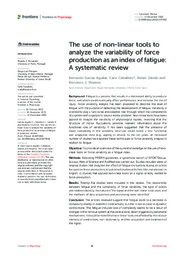Por favor, use este identificador para citar o enlazar este ítem:
https://hdl.handle.net/11000/34261Registro completo de metadatos
| Campo DC | Valor | Lengua/Idioma |
|---|---|---|
| dc.contributor.author | Caballero, Carla | - |
| dc.contributor.author | Moreno, Francisco Javier | - |
| dc.contributor.author | Barbado, David | - |
| dc.contributor.other | Departamentos de la UMH::Ciencias del Deporte | es_ES |
| dc.date.accessioned | 2025-01-10T09:06:07Z | - |
| dc.date.available | 2025-01-10T09:06:07Z | - |
| dc.date.created | 2022 | - |
| dc.identifier.citation | Frontiers in Physiology | es_ES |
| dc.identifier.issn | 1664-1078 | - |
| dc.identifier.uri | https://hdl.handle.net/11000/34261 | - |
| dc.description.abstract | Fatigue is a process that results in a decreased ability to produce force, and which could eventually affect performance and increase the risk of injury. Force variability analysis has been proposed to describe the level of fatigue with the purpose of detecting the development of fatigue. Variability is credited to play a functional and adaptive role through which the components of a system self-organize to solve a motor problem. Non-linear tools have been applied to analyze the variability of physiological signals, revealing that the structure of motor fluctuations provides relevant information about the functional role of variability. It has been suggested that the presence of lower complexity in the variability structure could reveal a less functional and adaptative state (e.g., ageing or illness). In the last years, an increased number of studies have applied these techniques to force variability analysis in relation to fatigue. | es_ES |
| dc.format | application/pdf | es_ES |
| dc.format.extent | 16 | es_ES |
| dc.language.iso | eng | es_ES |
| dc.publisher | Frontiers | es_ES |
| dc.relation.ispartofseries | 13 | es_ES |
| dc.rights | info:eu-repo/semantics/openAccess | es_ES |
| dc.rights | Attribution-NonCommercial-NoDerivatives 4.0 Internacional | * |
| dc.rights.uri | http://creativecommons.org/licenses/by-nc-nd/4.0/ | * |
| dc.subject | force control | es_ES |
| dc.subject | strength | es_ES |
| dc.subject | non-linear | es_ES |
| dc.subject | complexity | es_ES |
| dc.subject | neuromuscular fatigue | es_ES |
| dc.title | The use of non-linear tools to analyze the variability of force production as an index of fatigue: A systematic review | es_ES |
| dc.type | info:eu-repo/semantics/article | es_ES |
| dc.relation.publisherversion | https://doi.org/10.3389/fphys.2022.1074652 | es_ES |

Ver/Abrir:
2022_JCR_18_FP_The use of non-linear tools to.pdf
1,7 MB
Adobe PDF
Compartir:
 La licencia se describe como: Atribución-NonComercial-NoDerivada 4.0 Internacional.
La licencia se describe como: Atribución-NonComercial-NoDerivada 4.0 Internacional.
.png)